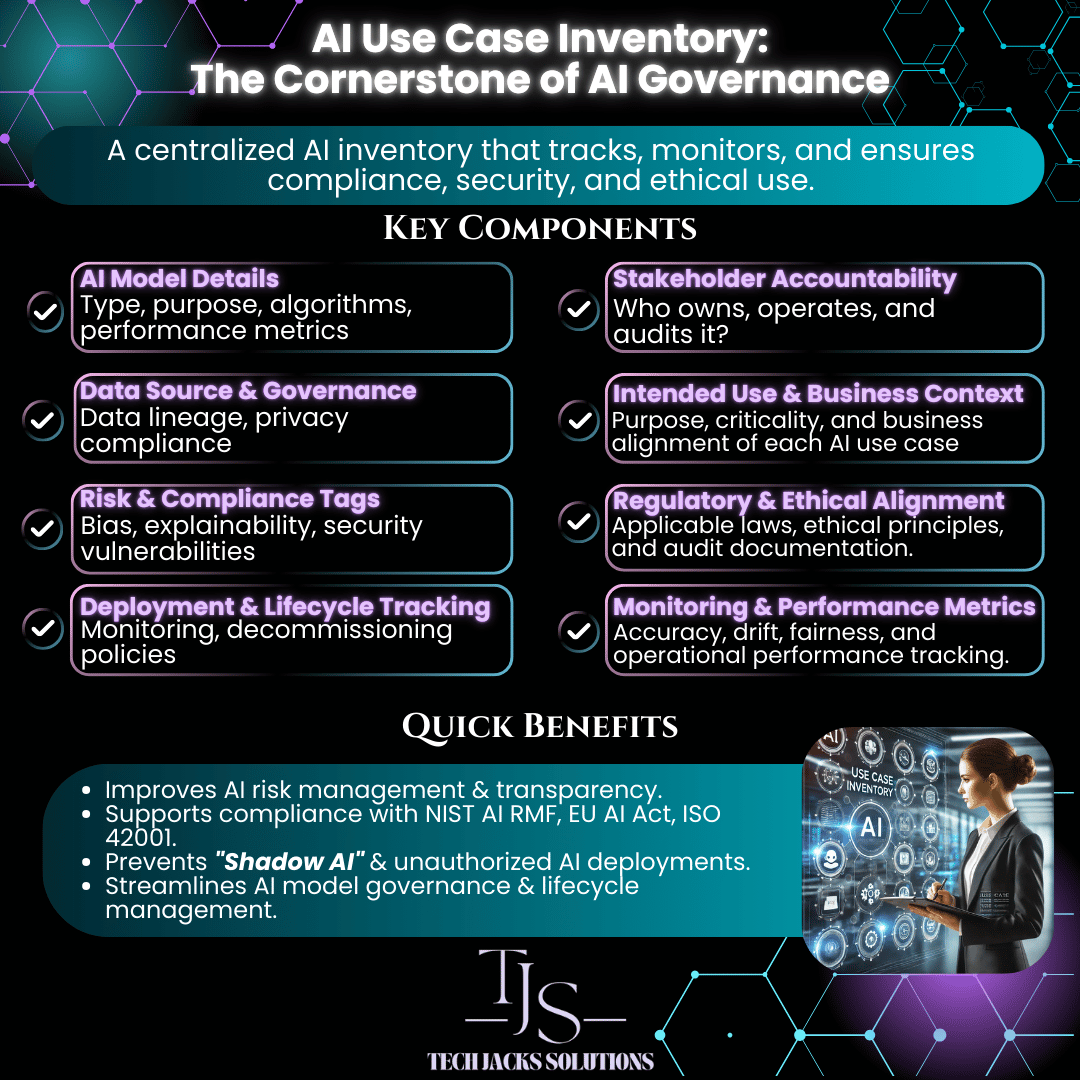AI Use Case Inventories
When we dove into AI governance, we underestimated just how crucial tracking AI deployments would be. Sure, it’s easy to get lost in the thrill and excitement of shiny new tools, but as anyone who’s ever tried juggling too many platforms at once will tell you: complexity spirals fast. An AI Inventory is an essential tool that can help keep chaos at bay, and today, I am sharing exactly how to build one effectively.
When Should You Start Your AI Inventory?
Start documenting your AI systems now. Knowing what AI tools you’re using (and where) forms the foundation of any governance strategy. Ideally, you’d catalog AI use cases while exploring new tools and features. But most organizations have already adopted AI in some form. If that’s you, start today. Don’t wait for a compliance audit or operational crisis to force your hand. Learning from mistakes isn’t illegal.
Why an AI Inventory is Crucial for Governance
An AI Use Case Inventory is foundational to truly responsible and effective AI governance. Its key objectives include:
- Transparency: Clearly documenting every AI system in your organization: detailing purposes, data usage, stakeholders, and associated risks. This helps to ensure accountability and trust.
- Compliance: Supports identification of applicable regulatory requirements, regulatory gaps and blind spots (think GDPR Art.22, NIST AI RMF, the EU AI Act, and more) before they escalate into real headaches.
- Risk Management: Allowing for the proactive mitigation of security vulnerabilities, ethical concerns, and bias-related issues before they cause tangible harm or regulatory scrutiny.
- Strategic Alignment: Ensuring each AI deployment directly contributes to strategic business objectives, preventing redundant or misaligned AI initiatives.
Without a comprehensive inventory, you’re essentially managing AI governance blindfolded. That’s neither effective or enjoyable
How to Ensure Your AI Inventory Actually Adds Real Value
Your AI Inventory must be more than just a static list. It should actively guide strategic decision-making and risk mitigation efforts. I’ve seen AI use case inventories implemented in list/grid view within Airtable (or Microsoft Lists) as a low-cost implementation that allows compliance committees to rapidly see what AI use cases exist and the various details associated with each one. Extremely helpful! Here’s a step-by-step breakdown to achieve this:
Detailed Step-by-step Breakdown:
- Identify and Catalog All AI Use Cases:
- Document every AI tool and deployment with clarity, detailing the intended business objectives, datasets involved, key stakeholders responsible, and specific intended outcomes.
- Classify Use Cases by Risk and Business Impact:
- Not all AI is equal. Classify each use case based on associated risks, data sensitivity, regulatory compliance requirements, and overall strategic impact on your organization.
- Link Clearly to Governance Objectives:
- Align every AI initiative explicitly to your broader organizational strategic goals and governance principles. If a use case doesn’t align clearly, seriously reconsider its implementation or continuation.
- Establish Regular Review and Approval Processes:
- Create and empower a cross-functional governance committee or working group to regularly review, validate, refine, and approve AI use cases. This ensures ongoing relevance, compliance, and alignment with your overall governance framework.
- Develop Clear Documentation Standards:
- Standardize how AI use cases are documented, including mandatory information such as data handling practices, model transparency, and ethical implications. This consistency will streamline reviews and audits.
Keeping Your AI Inventory Current
An AI Use case Inventory requires continous maintenance. Given AI’s rapid pace of evolution, your inventory must remain agile and updated. Practical tips for maintaining its accuracy and effectiveness include:
- Quarterly (or Frequent) Reviews: Schedule structured reviews every quarter or even monthly, depending on your organization’s pace of AI adoption. Regular reviews help capture new deployments, remove outdated initiatives, and maintain inventory accuracy.
- Leverage Automated Tracking Tools: Invest in software and platforms designed to automatically detect, document, and track AI components and use cases, significantly reducing manual effort and ensuring real-time accuracy and comprehensiveness.
- Assign Clear Stakeholder Responsibility: Clearly define and communicate responsibilities for maintaining the inventory. Assign dedicated individuals or teams within each department to regularly update their AI deployments, ensuring accountability and sustained accuracy.
- Check out our article on AI Governance Charters to help on the process of establishing these responsibilities.
- Check out our article on Why you need an AI Use Case Tracker (And What to Track) which explains each column and the value metadata gathered during the AI Lifecycle.
Building and maintaining a robust AI Use Case Inventory will become the continuous rhythmic beat of your AI governance framework1. If you’re committed to the responsible, secure, and strategic use of AI, a comprehensive and actively maintained inventory is an absolute necessity. It will save you a lot more headaches then it wil cause you, and shows demonstrative proof that you are practicing due care / due diligence.
Example AI Use Case Inventory Tracker
So, why keeping talking about an AI Use Case Tracker when we can show you one! Please take a look at our redumentry AI Use Case Inventory example:


